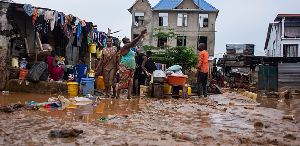Government urged to support deprived communities with sanitation problems
Accra, July 16, GNA - A study conducted on assessing community water and sanitation in Ghana has suggested that government should support deprived communities that are unable to pay their five per cent cost for facilities under the HIPC funds.
For a community to qualify for a water project it has to pay a commitment fee, representing five per cent of the total cost of the project, which some of them are unable to afford.
The study suggested that in order not to deprive these communities of such basic and important amenities, government should intervene. The study was conducted in Ashanti, Central and Brong Ahafo regions under the African Technology Policy Studies Network (ATPS) project based in Nairobi, Kenya.
It was undertaken by the Dr Roseemma Mamaa Entsua-Mensah of the Water Research Institute, Dr George Essegbey, Acting Director of Science Technology and Policy Research Institute (STEPRI), Dr Godfred Frempong of STEPRI and Mrs Charlotte Engmann of the Community Water and Sanitation Agency (CWSA).
A copy of the report made available to the Ghana News Agency said it looked at the extent of the implementation of the policy for community and sanitation and assessed the effectiveness of the policy in terms of delivery to small communities and small towns.
It said the major concerns of the people had been the supply of potable water in communities of rural and semi-urban status where majority of the people lived.
Boreholes were the main water systems in the communities of study whilst hand-dug wells and small piped water systems were the least used. With sanitation, ventilated improved pit and pit latrines were the facilities mostly used whilst in rare cases water closet toilet was used in communities with small piped water systems.
The study revealed that the shift from the use of pubic toilets facilities to in-house toilets had not been successful and revealed the infectiveness of the CWSA programme.
It attributed the failure to the fact that the district assemblies were slow in paying their subsidies, which had not induced many households to construct their own facility.
"Most of the public toilets, especially the pit latrines were not well kept; they stank and were infested with maggots. They were without scheduled cleaning and got flooded after every heavy down pour. The structures were weak with serious roof leakages.
"The continuous use and high population of pit latrines are suggestive of failure of CWSA in achieving its sanitation mandate."
The study noted that there was viable community water and sanitation programme in the country but assessing its effectiveness indicated clearly that the programme had contributed substantially in extending access to potable water to marginalized communities with high degree of reliability in the three regions.
The enactment of the new water policy in 2005 has provided a framework for the sustainable development and utilisation of Ghana's water resources.
For Ashanti Region, the provision of good sanitation systems for households was very limited and only 17,908 people were covered in the programme with 2,126 household latrines and 18 institutional latrines from 1994 to 1999.
In the Water Policy component of the Community Water and Sanitation Programme (CWSP), only 262,050 people were served with boreholes and hand-dug wells in 522 communities in the Ashanti Region between 2000 and 2004.
During the CWSP 1, a total of 18 institutional latrines and 2,126 ventilated improved latrines projects were implemented in the Brong Ahafo Region in the sanitation policy from 1994 to 2000. A total of 158 institutional latrines and 926 ventilated improved latrines were executed between 2000 and 2004 under the CWSP 2 in Brong Ahafo.
In the Central Region, implementation of the programme was satisfactory with coverage of water increasing from 27 per cent to 60 per cent with a number of toilet facilities existing in the districts. The study said though the implementation of the programme had chalked some achievements, funds for the programme should be released on time whilst deprived communities that were not able to pay the five per cent cost of facilities be supported from the HIPC funds.
It also called for capacity building, computer training and increase in the range of the population size since a population of below 2,000 might not be able to mobilise the funds to benefit.
The lack of progress in improving sanitation in all the communities was identified as a key issue, which needed to be addressed by tackling the socio-cultural tendencies, which made the people in the communities downgrade the priority of good sanitation in raising the quality of life.
The study called for the design and construction of the sanitation systems to be made more affordable to communities whilst the communities were educated to appreciate the strong link between good sanitation and well-being.
"District Assemblies should enhance their contribution to the construction of sanitation systems in people's home," it said. It also called on government to set aside a fund that would promptly pay the subsidies to the rural people to accelerate the achievement of the policy. 16 July 07
General News of Monday, 16 July 2007
Source: GNA
Sanitation Report
Entertainment











